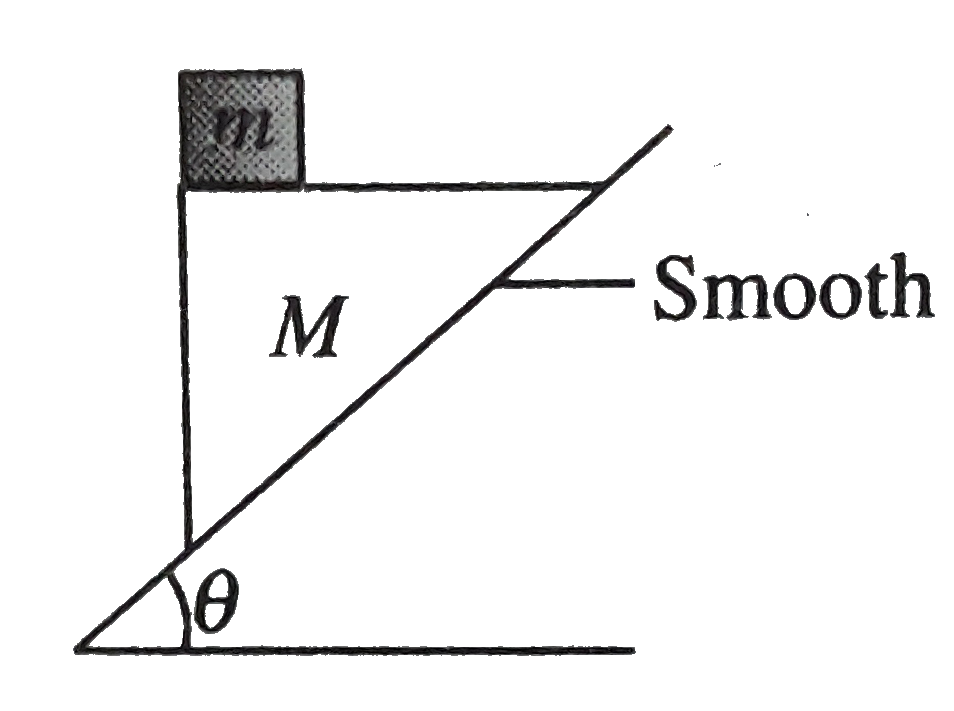A spherical object of mass m and radius R is released from the top of a smooth inclined plane of height h and angle of inclination is 37° . The radius of gyration of the object is K. The speed of object at the bottom of inclined plane is
√2gh
⎷2gh(1+K2R2)
√2gh(1+K2R2)
2√gh
To find the speed of a spherical object at the bottom of a smooth inclined plane, we can use the principle of conservation of mechanical energy. Here's a step-by-step solution:
Step 1: Understand the Initial and Final Energy
At the top of the inclined plane:
- The object has potential energy (PE) due to its height h.
- The initial kinetic energy (KE) is zero since the object is released from rest.
At the bottom of the inclined plane:
- The potential energy is zero (since height is zero).
- The kinetic energy consists of two parts: translational kinetic energy and rotational kinetic energy.
Step 2: Write the Energy Conservation Equation
Using the conservation of mechanical energy, we can write:
Initial Potential Energy+Initial Kinetic Energy=Final Potential Energy+Final Kinetic Energy
This can be expressed as:
mgh+0=0+(12mv2+12Iω2)
Where:
- I is the moment of inertia of the spherical object.
- ω is the angular velocity.
Step 3: Relate Linear and Angular Velocity
For a rolling object, the relationship between linear velocity v and angular velocity ω is given by:
v=rω
Where r is the radius of the sphere.
Step 4: Moment of Inertia for a Sphere
The moment of inertia I for a solid sphere about its center of mass is given by:
I=25mr2
Step 5: Substitute into the Energy Equation
Substituting I and ω into the energy equation gives:
mgh = \frac{1}{2} mv^2 + \frac{1}{2} \left(\frac{2}{5} m r^2\right \left(\frac{v}{r}\right)^2
This simplifies to:
mgh=12mv2+15mv2
Step 6: Combine the Kinetic Energy Terms
Combining the kinetic energy terms:
mgh=(12+15)mv2
Calculating the fractions:
12+15=510+210=710
So we have:
mgh=710mv2
Step 7: Solve for v2
Cancel m from both sides (assuming m≠0):
gh=710v2
Rearranging gives:
v2=10gh7
Step 8: Solve for v
Taking the square root of both sides:
v=√10gh7
Final Answer
The speed of the object at the bottom of the inclined plane is:
v=√10gh7
---
At the top of the inclined plane:
- The object has potential energy (PE) due to its height h.
- The initial kinetic energy (KE) is zero since the object is released from rest.
- The potential energy is zero (since height is zero).
- The kinetic energy consists of two parts: translational kinetic energy and rotational kinetic energy.
Using the conservation of mechanical energy, we can write:
- I is the moment of inertia of the spherical object.
- ω is the angular velocity.
For a rolling object, the relationship between linear velocity v and angular velocity ω is given by:
The moment of inertia I for a solid sphere about its center of mass is given by:
Substituting I and ω into the energy equation gives:
mgh = \frac{1}{2} mv^2 + \frac{1}{2} \left(\frac{2}{5} m r^2\right \left(\frac{v}{r}\right)^2
Combining the kinetic energy terms:
Cancel m from both sides (assuming m≠0):
Taking the square root of both sides:
The speed of the object at the bottom of the inclined plane is:
Topper's Solved these Questions
- TEST 1BOOK - AAKASH INSTITUTE ENGLISHCHAPTER - TEST 1EXERCISE - EXERCISE
21 Videos
- SYSTEM OF PARTICLES AND ROTATIONAL MOTIONBOOK - AAKASH INSTITUTE ENGLISHCHAPTER - SYSTEM OF PARTICLES AND ROTATIONAL MOTIONEXERCISE - Try Yourself
63 Videos
- TEST 2BOOK - AAKASH INSTITUTE ENGLISHCHAPTER - TEST 2EXERCISE - Exercise
308 Videos
Similar Questions
Two objects, a ring and a spherical shell of same mass and radius are released from the top of two Identical inclined plane. If they are rolling without slipping, then ratio of speed of center of mass of the two objects when they will reach the bottom of the inclined plane is
View SolutionA body is slipping from an inclined plane of height h and length l . If the angle of inclination is θ , the time taken by the body to come from the top to the bottom of this inclined plane is
View Solution
Knowledge Check
An object of mass m is released from rest from the top of a smooth inclined plane of height h. Its speed at the bottom of the plane is proportional to
Am0BmCm2Dm−1
A body of mass m and radius r is released from rest along a smooth inclined plane of angle of inclination θ. The angular momentum of the body about the instantanoues point contact after a time t from the instant of release of equal is :
View SolutionA triangular prism of mass m placed on it is released from rest on a smooth inclined plane of inclination θ The block does not slip on the prism. Then

View SolutionA hollow sphere is released from top of an inclined plane of inclination 30º and length of inclined plane is /. If sphere rolls without slipping then its speed at bottom is
View SolutionA disc of radius R is rolling down an inclined plane whose angle of inclination is θ Its acceleration would be
View SolutionA spherical shell of mass m and radius R is rolling up without slipping on a rough inclined plane as shown in the figure. The direction of static friction acting on the shell is
View SolutionA uniform disc is released from the top of a rough inclined plane of angle θ and height h. The coefficient of friction between the disc and the plane is μ=tanθ4. The speed of centre of mass of disc on reaching the bottom of the plane is
View SolutionA sphere is released on a smooth inclined plane from the top. When it moves down, its angular momentum is
View Solution
